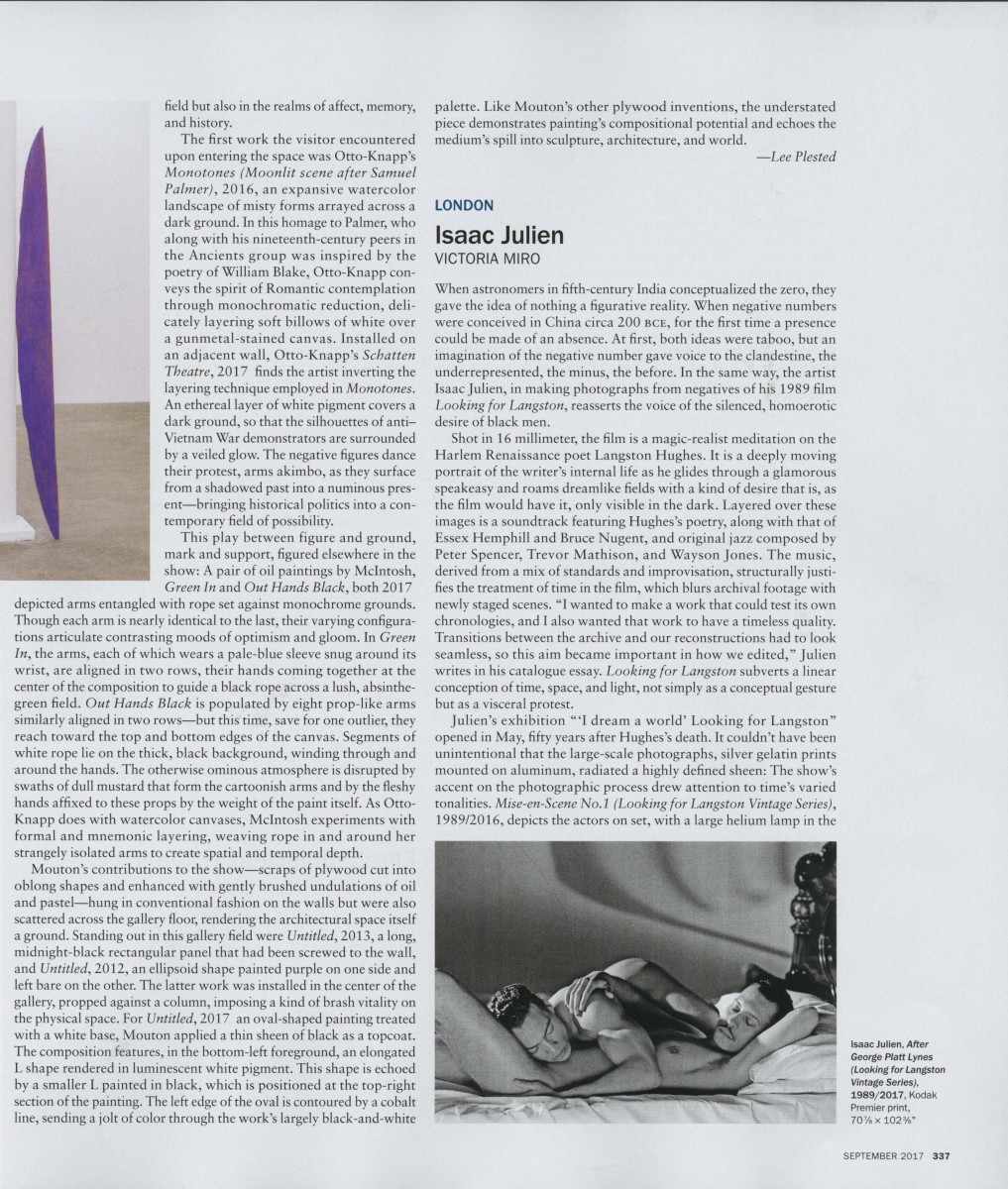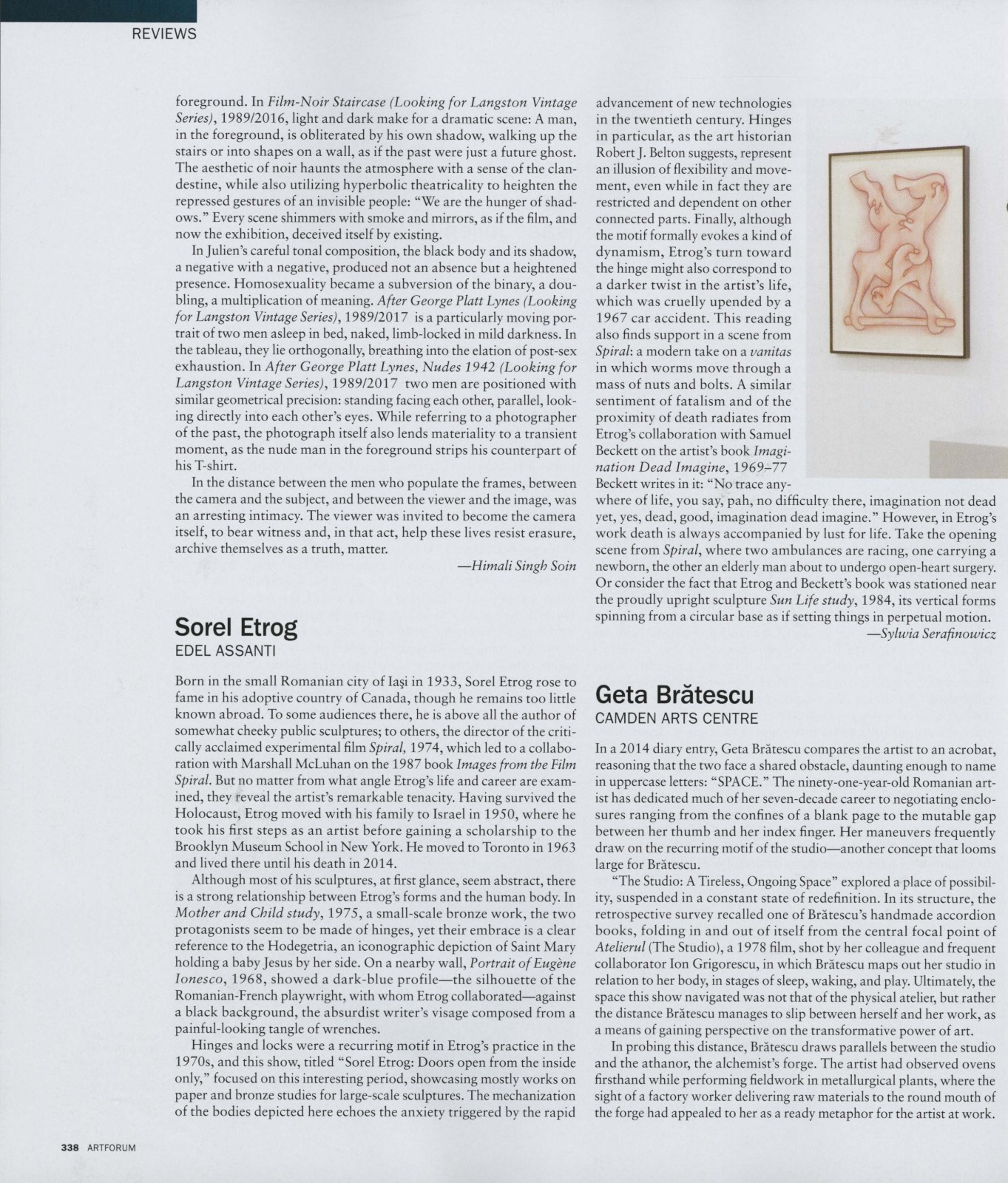'Looking for Langston' in Artforum
Read Himali Singh Soin's review of ''I Dream A World' Looking for Langston' at Victoria Miro Gallery, London, in the September copy of Artforum;
'When astronomers in fifth-century India conceptualized the zero, they gave the idea of nothing a figurative reality. When negative numbers were conceived in China circa 200 BCE, for the first time a presence could be made of an absence. At first, both ideas were taboo, but an imagination of the negative number gave voice to the clandestine, the underrepresented, the minus, the before. In the same way, the artist Isaac Julien, in making photographs from negatives of his 1989 film Looking for Langston, reasserts the voice of the silenced, homoerotic desire of black men.
Shot in 16 millimeter, the film is a magic-realist meditation on the Harlem Renaissance poet Langston Hughes. It is a deeply moving portrait of the writer's internal life as he glides through a glamorous speakeasy and roams dreamlike fields with a kind of desire that is, as the film would have it, only visible in the dark. Layered over these images is a soundtrack featuring Hughes's poetry, along with that of Essex Hemphill and Bruce Nugent, and original jazz composed by Peter Spencer, Trevor Mathison, and Wayson Jones. The music, derived from a mix of standards and improvisation, structurally justifies the treatment of time in the film, which blurs archival footage with newly staged scenes. "I wanted to make a work that could test its own chronologies, and I also wanted that work to have a timeless quality. Transitions between the archive and our reconstructions had to look seamless, so this aim became important in how we edited," Julien writes in his catalogue essay. Looking for Langston subverts a linear conception of time, space, and light, not simply as a conceptual gesture but as a visceral protest.
Julien's exhibition '"I dream a world' Looking for Langston" opened in May, fifty years after Hughes's death. It couldn't have been unintentional that the large-scale photographs, silver gelatin prints mounted on aluminum, radiated a highly defined sheen: The show's accent on the photographic process drew attention to time's varied tonalities. Mise-en-Scene No.1 (Looking for Langston Vintage Series), 1989/2016, depicts the actors on set, with a large helium lamp in the
foreground. In Film-Noir Staircase (Looking for Langston Vintage Series), 1989/2016, light and dark make for a dramatic scene: A man, in the foreground, is obliterated by his own shadow, walking up the stairs or into shapes on a wall, as if the past were just a future ghost. The aesthetic of noir haunts the atmosphere with a sense of the clandestine, while also utilizing hyperbolic theatricality to heighten the repressed gestures of an invisible people: "We are the hunger of shadows." Every scene shimmers with smoke and mirrors, as if the film, and now the exhibition, deceived itself by existing.
In Julien's careful tonal composition, the black body and its shadow, a negative with a negative, produced not an absence but a heightened presence.
Homosexuality became a subversion of the binary, a doubling, a multiplication of meaning. After George Platt Lynes (Looking for Langston Vintage Series), 1989/2017 is a particularly moving portrait of two men asleep in bed, naked, limb-locked in mild darkness. In the tableau, they lie orthogonally, breathing into the elation of post-sex exhaustion. In After George Platt Lynes, Nudes 1942 (Looking for Langston Vintage Series), 1989/2017 two men are positioned with similar geometrical precision: standing facing each other, parallel, looking directly into each other's eyes. While referring to a photographer of the past, the photograph itself also lends materiality to a transient moment, as the nude man in the foreground strips his counterpart of his T-shirt.
In the distance between the men who populate the frames, between the camera and the subject, and between the viewer and the image, was an arresting intimacy. The viewer was invited to become the camera itself, to bear witness and, in that act, help these lives resist erasure, archive themselves as a truth, matter.'
- Himali Singh Soin




